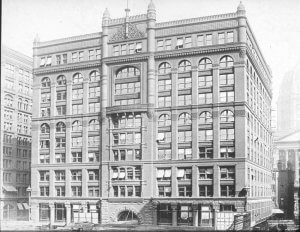Chicago School - Architecture, Art and Design

There have been many artistic movements throughout history and several of them continue to impact the world of design. For example, the Chicago School is one of the most influential.
The USA was once a true center of innovation, production, and development. So the Chicago School was a pioneer when it came to architecture and design.
We must emphasize that their work was a design turning point and incorporated art into buildings. They became a design influence and subsequently inspired many architects and designers.
A little bit about the Chicago School

The Chicago School emerged in the late nineteenth and early twentieth centuries. This movement was formed by a large number of artists, some of them were architects who were well-known for their innovative designs.
What made this school so special? Well, they introduced new materials and construction techniques. Also, they presented new horizons and a new city aesthetic. Their goal was to get out of the usual norm and open new paths of expression.
In turn, these designers stood out for a type of construction that wasn’t known at the time: the skyscraper. The large dimensions of those buildings was a truly original feature back then. So, they challenged the artistic dynamics of the time.
Art follows form
Art as seen by Richardson and Sullivan

Both Henry Hobson Richardson and Louis Sullivan saw a mans to express themselves through architecture and interior design. They believed that every detail in a house should be carefully planned in order for it to be art.
- Richardson’s works have consistent wide walls based on straight lines and basic forms used as structures.
- As for Sullivan, he tried to highlight the most emphatic verticality of the buildings. Straightness prevails in most of them, but, above all, there are blocks. The Sullivan Center, formerly Carson building, is a great example of this.
- Actually, the works of both architects are very personal; that is, they have certain elements that make them unique and whole. So, their work truly stands out in comparison to the monotony of city aesthetics.
- Mass production went out in favor of a more unique type of construction.
- Also, they began to use steel beams and concrete.
What’s inside?

The Chicago School buildings stood out primarily for the way their exteriors looked. But, what was inside? Some of their interior features are:
- Geometry and linearity, just like the exterior. In them, the external appearance speaks of what’s inside and serves as a preamble.
- Transparency is a well-established concept in these buildings, and its purpose is to attain breadth and openness.
- Perspective is the foundation of these buildings. You can see some really amazing views from the street but the interior has all sorts of angles that make them quite original.
- Creativity is one of these artists’ strengths because they exploited any resource they had at hand in their interior designs.
Chicago School – its impact and influence in interior design

The impact of these works was huge at the time. People considered them innovative in many areas and the work served as models for the development of new architectural concepts.
So, remember that one must have inspiration and creativity in order to develop new constructive processes. Therefore, the Chicago School is a point of reference when it comes to skyscrapers.
In short, the Chicago School is still considered one of the main hubs of inventiveness and innovation.
There have been many artistic movements throughout history and several of them continue to impact the world of design. For example, the Chicago School is one of the most influential.
The USA was once a true center of innovation, production, and development. So the Chicago School was a pioneer when it came to architecture and design.
We must emphasize that their work was a design turning point and incorporated art into buildings. They became a design influence and subsequently inspired many architects and designers.
A little bit about the Chicago School

The Chicago School emerged in the late nineteenth and early twentieth centuries. This movement was formed by a large number of artists, some of them were architects who were well-known for their innovative designs.
What made this school so special? Well, they introduced new materials and construction techniques. Also, they presented new horizons and a new city aesthetic. Their goal was to get out of the usual norm and open new paths of expression.
In turn, these designers stood out for a type of construction that wasn’t known at the time: the skyscraper. The large dimensions of those buildings was a truly original feature back then. So, they challenged the artistic dynamics of the time.
Art follows form
Art as seen by Richardson and Sullivan

Both Henry Hobson Richardson and Louis Sullivan saw a mans to express themselves through architecture and interior design. They believed that every detail in a house should be carefully planned in order for it to be art.
- Richardson’s works have consistent wide walls based on straight lines and basic forms used as structures.
- As for Sullivan, he tried to highlight the most emphatic verticality of the buildings. Straightness prevails in most of them, but, above all, there are blocks. The Sullivan Center, formerly Carson building, is a great example of this.
- Actually, the works of both architects are very personal; that is, they have certain elements that make them unique and whole. So, their work truly stands out in comparison to the monotony of city aesthetics.
- Mass production went out in favor of a more unique type of construction.
- Also, they began to use steel beams and concrete.
What’s inside?

The Chicago School buildings stood out primarily for the way their exteriors looked. But, what was inside? Some of their interior features are:
- Geometry and linearity, just like the exterior. In them, the external appearance speaks of what’s inside and serves as a preamble.
- Transparency is a well-established concept in these buildings, and its purpose is to attain breadth and openness.
- Perspective is the foundation of these buildings. You can see some really amazing views from the street but the interior has all sorts of angles that make them quite original.
- Creativity is one of these artists’ strengths because they exploited any resource they had at hand in their interior designs.
Chicago School – its impact and influence in interior design

The impact of these works was huge at the time. People considered them innovative in many areas and the work served as models for the development of new architectural concepts.
So, remember that one must have inspiration and creativity in order to develop new constructive processes. Therefore, the Chicago School is a point of reference when it comes to skyscrapers.
In short, the Chicago School is still considered one of the main hubs of inventiveness and innovation.
All cited sources were thoroughly reviewed by our team to ensure their quality, reliability, currency, and validity. The bibliography of this article was considered reliable and of academic or scientific accuracy.
Preckler, Ana María: Historia del arte universal de los siglos XIX y XX, Madrid, Complutense, 2003.







